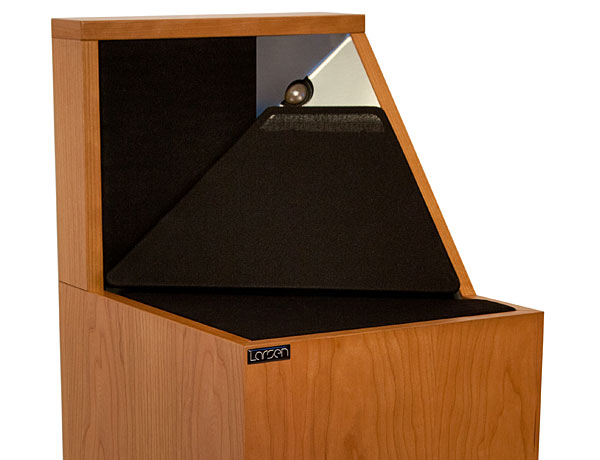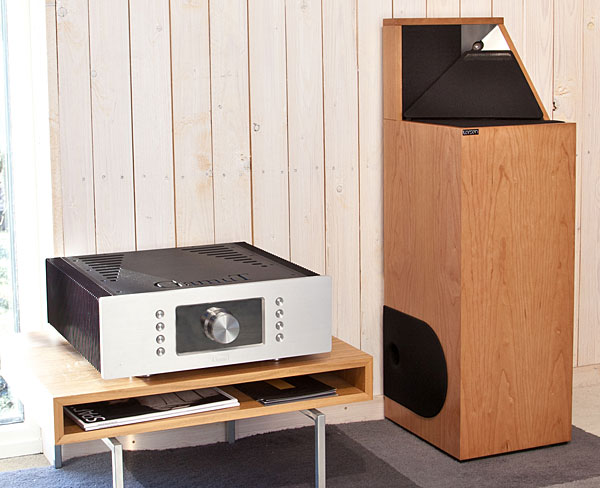| Columns Retired Columns & Blogs |
Do Stereophile reviewers have access to John Atkinson's measurements when they write their reviews?
Notwithstanding my love for both the appearance and the large size of my favorite vintage and vintage-inspired speakers, I enjoyed having in my room the relatively inconspicuous Larsen 8s. Though the ca-1966 Altec Flamenco might look at home in the drawing room of a Victorian hookah merchant, the Larsen 8 . . . well, the Larsen 8 simply wouldn't. Though it impresses as a stylish loudspeaker, its style is born not of filigree but of the very essence of its minimalist, modernist, functionalist shape.
Listening
My well-traveled review pair of Larsen 8s needed only a little time to run in—perhaps an hour or so—before their woofers woke up and remembered what they were supposed to be doing. Notably, at no time during their stay in our home did the Larsens add to the signals fed them any grit, spit, grain, or other artifacts.
Indeed, from their first day here to their last, the Larsen 8s sounded a bit rolled off at both frequency extremes. Trebles were soft—a recording in which vocal sibilants were borderline hot was instantly tamed, yet a distantly miked tambourine in the same recording lost a small measure of its musical effectiveness—and instruments with fundamentals in the lowest octaves sounded a little cushier than usual, though not unpleasantly so. Overall, the 8s were well balanced from top to bottom. Still, 23Hz tones were beyond their capabilities, at least in my installation; the lowest frequency at which they supplied plainly audible and useful output was about 40Hz.

Well-recorded jazz sounded wonderful through the Larsens: slightly scaled down compared to my Flamencos in spatial size and impact, but very convincing nonetheless. "Lorraine," from Ornette Coleman's Tomorrow Is the Question! (LP, Contemporary S7569), was beautifully colorful yet without apparent colorations, and the sense of impact from Shelly Manne's floor tom and bass drum, and from the note attacks of bassist Red Mitchell, was very satisfying. Again, I didn't hear the same amount of force as through my Altecs or the Auditorium 23 Hommage Cinemas, and the size of the Larsens' soundstage was less than enormous. Yet, in a strange way, those two slight and seemingly interrelated shortcomings were less objectionable than I might have expected. Again, once I'd sat down and acclimated myself to the Larsens' style of sound, the music itself was extremely satisfying. I never felt at a loss.
Similarly, in "Tanya," from Dexter Gordon's One Flight Up (LP, Blue Note/Cisco Music 84176), Art Taylor's drumming and the inventive bass playing of Niels-Henning Ørsted Pedersen (a Dane!) were reproduced with good impact, while Gordon's saxophone had superb tone, texture, and presence. And in "Taxman," from the Beatles' Revolver (LP, Parlophone PCS 7009), Paul McCartney's similarly inventive bass playing had shockingly good depth, drive, and punch, and his superb guitar solos bristled with energy and snarly good tone—although John Lennon's tambourine was, weirdly, almost entirely missing in action.
Only with certain examples of large-scale music, such as the Electric Recording Company's reissue of soloist Leonid Kogan's recording of the Brahms Violin Concerto with Kiril Kondrashin and the Philharmonia Orchestra (LP, Columbia SAX 2307/ERC 027), did I actually miss the scale and the drive—the latter especially in the low frequencies—of my own speakers. And even then, I wondered if perhaps giving the Larsens more amplifier power and/or a larger room—with speakers and listener spaced farther apart—might be more satisfying in those regards. (Larsen's US distributor submitted the 8s knowing that I'd be driving them with my 25W Shindo Corton-Charlemagne monoblocks. As for room size, although I considered using the 8s in my much larger living room, that space has no boundaries suitable for against-the-wall speakers.)
That said, when I played the very good Speakers Corner reissue of Hermann Scherchen and the Vienna State Opera Orchestra's recording of Rimsky-Korsakov's Scheherazade (LP, Westminster/Speakers Corner WST 14003)—one of those vinyl reissues that genuinely improves on even a mint copy of the original—I was impressed by the Larsens' good-for-their-enclosure-size sense of scale, their excellent touch with plucked strings, and their timbrally and texturally convincing portrayals of solo bassoon, oboe, and other woodwinds.
Playing to the Larsens' apparent strengths, I reverted to smaller-scale music, including the Seldom Scene's 1975 album Live at the Cellar Door (2 LPs, Rebel SLP-1547/48). The Larsen 8s presented the sounds of the group's acoustic instruments with clarity and very good spatial presence. The soundstage wasn't terribly deep, but soloists stood proud of the mix when needed, as with John Duffey's mandolin playing in "Rawhide"—also notable for its believably forceful note attacks. In "Muddy Waters," the harmonizing singers were convincingly spread across the stage—and, again, Duffey's mandolin solo had excellent force, eerily bent notes and all.
In "Emily," from Joanna Newsom's Ys (LP, Drag City 303), the Larsens succeeded in getting across the increasing intensity with which the strings—especially the bass viols—accompany Newsom's voice in the song's first minutes. As "Emily" proceeds and the arrangement grows in complexity, the Larsens reproduced the sounds of violins, violas, cellos, double basses, and even banjo and jaw harp with good image placement across a stage that was pleasantly wide but, again, not terribly deep. I also heard less blurring and greater precision of pitch in the improvisations by bassist Lee Sklar than I have through virtually any speaker other than the Quad ESL.

The only disappointment in the way the Larsens reproduced Ys was what appeared to be a very slight cupped-hands or "head-cold" coloration in Newsom's voice. I heard the same slight darkening in Joni Mitchell's voice in "Morning Morgantown" and "For Free," from her Ladies of the Canyon (LP, Reprise 6376). Male singers, perhaps owing to their different timbral balance, weren't affected to the same extent—yes, the great tenor Peter Pears sounded a semishade darker than usual in his recording, with Benjamin Britten on piano, of Schubert's Die schöne Müllerin (LP, Decca SXL 2200), but this was noticeable only in the bubblier numbers, and was lost in the welcome gravitas of the songs nearer the end of the cycle. It should also be noted that "Pause" sounded especially wonderful through the Larsens—a high point in this recording, both for Pears's brilliantly poetic interpretation and Britten's appropriately deliberate playing.
I didn't know what to expect from these speakers when playing mono records, and it turned out that they cast neither a big, chunky, well-centered block of sound—which is what I get from my Altecs, and is what I most enjoy when listening to mono recordings—nor the comparatively tidy, small sound I get from my Quad ESLs, but rather a flat and surprisingly wide aural expanse. From the mono version of Procol Harum's Shine On Brightly (LP, Regal Zonophone LRZ 1004), both the title track and "Magdalene (My Regal Zonophone)" sounded enjoyably big—wider than through my Altecs, if not so tall.
Conclusions
Let's not beat around the bush: I think the Larsen 8 is a very good loudspeaker. While my large, horn-loaded Altecs are more to my taste, the Larsen is nonetheless musically and, for the most part, sonically satisfying. And the notion of pushing my preferences a few degrees to the left (yes, to the left) to accommodate such a thing is not outside the realm of the possible.
*******
Pay the bills though it does, there is an aspect of audio reviewing that I dislike: It forces me to think in ways the mere record-loving me would never consider. Reviewing sometimes forces me to think like a neurotic audiophile: someone who thinks too much about the gear through which he's listening, and is thus more or less bent on ruining the hobby for himself.
Reluctant parasite that I am, I would prefer to simply endure, happily and mental-healthily, in my love of listening to good records through good gear, thinking be damned. When I dropped the Larsen 8 loudspeakers into my system and set about enjoying them as a normal person might, I approached that ideal: I was immensely happy. Once I got what they were all about, even the hazards of audiophilia—the fidgets, the neuroses, the fetishes—couldn't diminish my regard for the Larsen 8 experience.
So let me put it to you this way: The Larsen 8 isn't for everyone. It's for those who just want a pair of speakers that will last them the next 20 years or so, and will provide insight, enjoyment, comfort and ease, and the occasional thrill. If that's you—and especially if you're also the sort who wouldn't mind getting off the audio merry-go-round for a while—the Larsen 8 is an easy recommendation.

Do Stereophile reviewers have access to John Atkinson's measurements when they write their reviews?

Do Stereophile reviewers have access to John Atkinson's measurements when they write their reviews?
No. It is very important for them not to see the measurements, because there would be the danger that they might then hear what they see.
John Atkinson
Editor, Stereophile


There is a very interesting Manufacturer's Comment on this review's measurements in the current issue, along with a reality check by JA.

Speakers which are theoretically bizarre are almost always interesting, and this one appears to have you listening to every single driver off every single driver's axis, (although it's hard to see where the one that is _partially obscured by a metal plate in its head_ is aiming.)
I was once pleasantly surprised by a little, costly FJ "The Ohm" in a short audition, but at least that one had the tweeter aiming forward. Not sure how many of the drivers in the multi way Shahinians aim at the listener.

I listened to the Larsen 4s (the little brother of Larsen 8) at T.H.E. Show Newport and was very impressed. The acoustic guitarist on the playback track was in-the-room and playing.
Independent of the gear price, I didn't quite succeed to experience this level of realism at the show in any other room!
Thank you for this review.
Regards, Babak
Hi-Reality Project